Now & New
- Experience
Hiroshima Castle’s Yoasobi: Famous Warriors Unite at Night
In recent years, the word “yoasobi” has entered the ears of many worldwide thanks to a J-pop group, but the word obviously predates said band. Easily put, yoasobi literally means “night play,” and refers to any form of entertainment that takes place at night (take that however you will). I’m sure many people’s minds will have shifted to activities not appropriate to this website, but let me just reign them in and talk about drinking at bars and clubs, or singing and otherwise being goofy at karaoke. When people think about things to do in Hiroshima City at night, the first ideas to pop up are those kinds of places, which don’t exactly sound the most exciting as a child being dragged around downtown by his or her family. Besides festivals in the spring, summer, and fall, once in a while there will be some family-friendly event at dusk, like the Museum of Art or aquarium opening later (typically a summer), or local Halloween celebrations put on for the kiddos, but yoasobi for kids tends to fall short in the winter.

As recently as a few months ago, Hiroshima Castle started holding a “Yoasobi” event on its grounds, wherein folks in historically accurate ninja and samurai garb gather and perform for the public. Troupes from castles all over Japan are invited to Hiroshima Castle to strut their stuff in terms of kenbu (剣舞 – sword dance) as well as modern song and dance routines. The party starts at dusk and continues well into 8:00 p.m., perfectly aligned with children’s dinner and bedtimes, allowing the little ones to watch history brought to life and end their weekend on a high note. The Yoasobi I attended may not have been the first one, but it happened to fall on Japan’s National Foundation Day, so watching Sengoku period-style actors duke it out at Hiroshima Castle seemed like an ideal way to observe said public holiday.
Prelude to Yoasobi
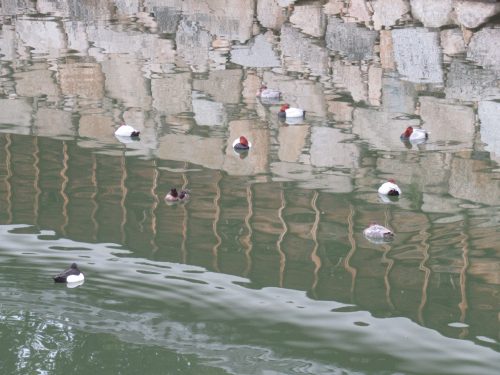
The show wouldn’t start until 5:00 p.m., but the castle grounds opened up for festivities at 4:00 p.m. so I got there early to take some serene pictures of Hiroshima Castle before the sun set. What would be tea time for us humans was apparently nap time for the ducks living in the castle moat, so I got this cute shot of them balled up and sleeping while floating on the water’s surface without a care. After that, I still had a whole hour before the performance began, so I stuck around the entrance to the castle and tried to snap a picture-perfect photo of the gate and turret devoid of any other humans, who were constantly entering and leaving. It took me a full fifty minutes of patience, frustration, and possibly obstructing the view of other photographers before I finally took the picture below, and by then, it was time for me to walk toward the stage area within.

I crossed the plaza in front of the Gokoku Shrine and climbed some stairs to a wide space not too far from the keep, where a stage and rows of benches had been set up and guests were already seated. It wasn’t posted on any of the benches or nearby signs, but there was this rule that only permitted three people to a bench in the name of social distancing, which I had to find out the hard way. After some confusion, I finally found a good seat with minimal visual interference from the people and tripods in front of me, and I was just in time for the show to start!
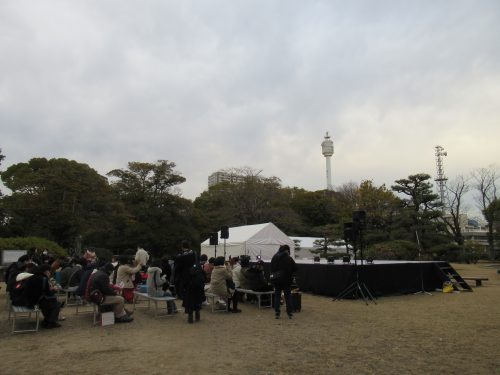
Team Hiroshima, Team Kumamoto, & Team Okazaki
The first representatives on stage were members of the Aki Hiroshima Bushotai, who kicked off the event with a sick ninja duel before introducing the flow of events tonight. They also acted as MCs and informed the audience of who would be coming up next, and more importantly, they explained the concept of “Hyakuman Isshin,” an anachronistic version of fist pumping that would be utilized by the audience throughout the night. I could understand the speaker’s explanation in Japanese, but the thought that they even prepared a sign in English in anticipation of an international audience was a thoughtful gesture that touched me.

After a couple more kenbu demonstrations, Team Hiroshima introduced the next performers, the Kumamoto Castle Omotenashi Bushotai, who came all the way from…you guessed it: Kumamoto! The actors here had more impressive fight choreography skills, but what was even more amazing than that was finding out that the actress who played Yasohime (八十姫), the lady on the right, was fully bilingual. She inquired about members of the audience from overseas, gave a brief explanation of the Sengoku period (oversimplified as being over 400 years ago), and clarified what would be going on for the rest of the night, all in English! Following that, she switched back into Japanese to instruct the crowd on how to cheer, and it was at this point where the mood became more like yoasobi as we understand the word, because it was starting to feel less like a historical re-enactment and more like a pop idol concert. For instance, we were told to shout, “Yaso-chan!” every time Yasohime’s name was mentioned, and shouts from the audience became frequent to the point of being plain silly, but laughter is what we all came here for, was it not?
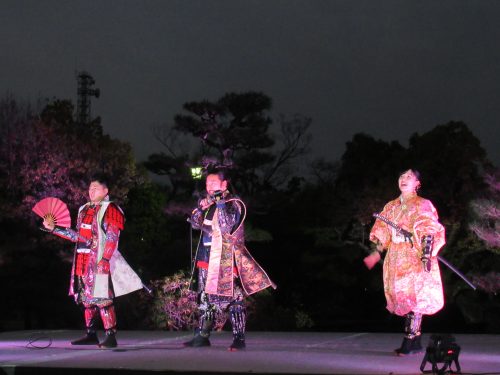
Following Team Kumamoto was the Great Duke Ieyasu “Aoi” Bushotai, representing Okazaki Castle in Aichi Prefecture. Honest to goodness, when their spiel began, I thought I was watching a comedy skit, and throughout their performance, it was clear that comedy outweighed combat. In fact, I didn’t like what I saw at first, but as their act got livelier and they taught us some dance moves we could use to follow along with their hijinks, my opinion of them steadily shifted toward a positive stance. Team Okazaki was unquestionably the funniest troupe we saw that night, and before you ask, yes, I too was participating in whatever they asked us to do while I wasn’t taking pictures or recording video.
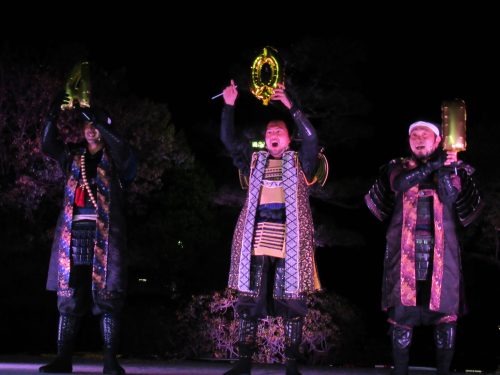
Moment of Joy: Fooling Around Together
Near the end of Team Okazaki’s dance number, actors from other troupes—from those who performed prior such as Team Kumamoto to those yet to have a turn like Team Kobe—took the stage to join the party. The entire venue turned into one, gargantuan, silly party involving both the performers and spectators, like a concert and an Obon dance fused together. Just by looking at the interactions between all the actors on stage, one could see the unshakable unity among all the troupes that showed up tonight, and it gave off a warm, fuzzy feeling. If there was any part of tonight that could sum up the essence of Yoasobi at Hiroshima Castle, the following video does a better job than any mock duel or weapon demonstration I saw.
Team Sendai and Team Kobe
The fourth troupe of the night was Oshu Sendai Omotenashi Group Date Bushotai, which, as its name suggests, is headed by none other than the legendary Date Masamune himself! This troupe made the longest journey of all the participants, coming all the way from Sendai. Think about it: these feudal warriors who lived during a time when humans couldn’t fly, brought their weapons and armor aboard an airplane bound for Hiroshima. Can you imagine how difficult it must have been for these men and women to check in katanas and polearms with Ibex Airlines and how many times they probably had to explain their circumstances? Yeah, neither can I, and I believe the less I think about it, the better.
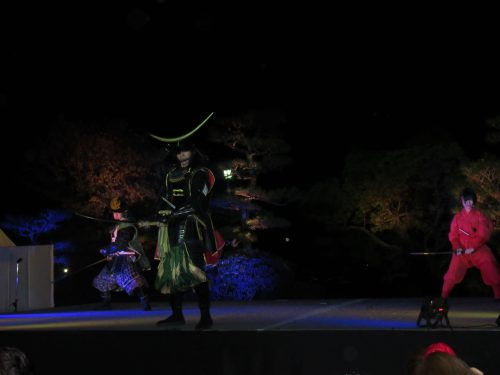
Besides the magnificent swordplay put on by the fearsome, esteemed Date Masamune and his cohort, the trio also demonstrated the real power of their weapons by slicing newspaper with a single blow. One man tried with his spear while his colleague, Hibiki the kunoichi (female ninja), held the newspaper with fear. The spear didn’t quite split the paper, so Date had to step in with his katana to show everyone how it was truly done. Date’s sword cleaved the newspaper clean in two, much to Hibiki’s relief, and up until Team Sendai’s performance, visitors also had the chance to participate in the very same newspaper-slicing experience elsewhere on the castle grounds. To wrap up their routine, this troupe also broke into song and dance, naturally inviting the warriors of other teams to join in and rile up the audience with their shenanigans.
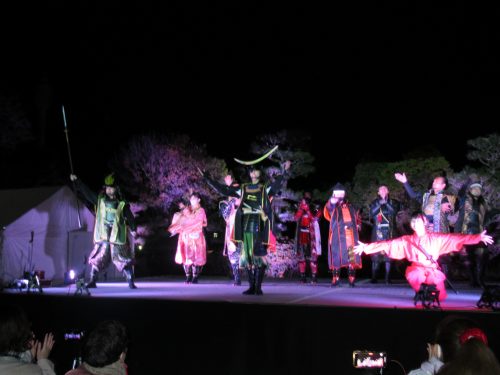
The final warrior troupe of the night was the Kobe Kiyomori Squad, fittingly named after renowned historical figure Taira no Kiyomori, a lord from Kobe with connections to Hiroshima. Taira no Kiyomori—who actually lived during the Heian period, before the time of some of the other characters that appeared tonight—allegedly sailed to Itsukushima to pray for a son, and that when his prayers were answered, he had a shrine built on the island, which came to be known as Miyajima (which literally means “shrine island”). Team Kobe managed to one-up Team Sendai by opening up with a rap number, something I didn’t expect even after everything I had seen that night. They followed that up with an equally awesome display of swordsmanship, with one of Taira’s vassals twirling a naginata with elegance before Taira himself took the stage with robust swings and thrusts from his katana. As you may be able to guess by now, this troupe also ended by inviting every other troupe on stage to sing and dance along as the historical part of the show was brought to a close.
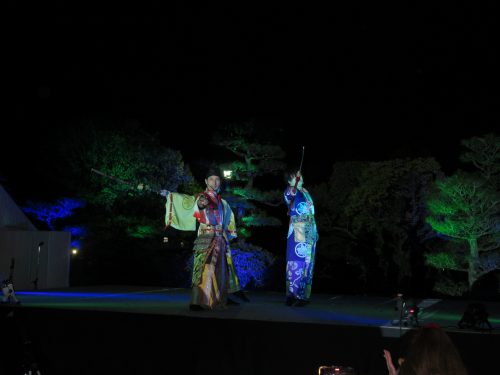
Other Forms of Yoasobi
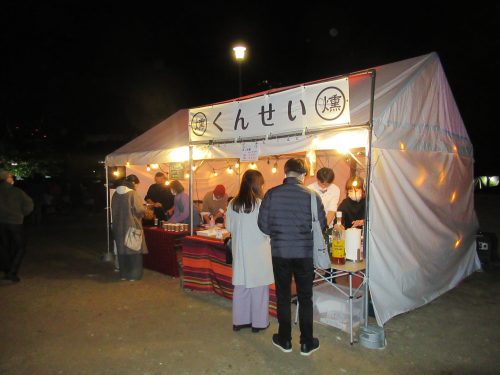
Of course, one didn’t have to be seated in front of the stage the whole time, as there was a lot more to see at the venue besides performances. Anyone who was hungry, thirsty, or just plain cold had the option of buying hot food or beverages from a nearby tent, but since I was watching the warriors on stage the entire time, they were sold out of food by the time I got there. Under another tent, the staff were promoting a treasure hunt for children to solve by snooping around the event site, but that was better solved while the sun was still up so I didn’t bother with it. The one activity I did do was the survey to be completed on my smartphone, which when finished, netted me a small food prize: a Fujiya Home Pie, which, as humble as it was, certainly beat not being able to eat at the event at all.
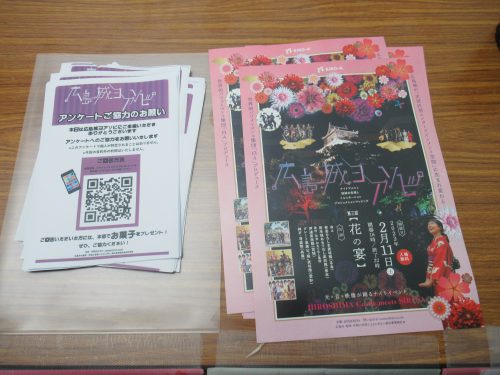
There were other tents at the venue leading to the keep of Hiroshima Castle, hosting fun activities such as shuriken-throwing and the newspaper-slicing that Date Masamune graciously exhibited for us on stage. However, those who wanted to play were advised to do so earlier in the afternoon or evening before the actors working these booths took the stage to perform; in other words, I was too late to play. The only other thing I could do at that point was to climb the stairs to take a nighttime photo of Hiroshima Castle’s keep, and proceed over to another area where a projector shone the name of the event, 広島城ヨアソビ (Hiroshima Castle Yoasobi), onto a nearby stone wall. Visitors were welcome to step in front of the projector and strike funny poses, an opportunity for “night play” and contributing to the projection mapping art that night.

The event lasted until 10:00 p.m., and after the warrior troupes, there were other performers such as SIRO A (pictured below) and even a mysterious guest on stage. Who was that mystery guest? Well, if I told you, you wouldn’t come here to check out Yoasobi, would you?
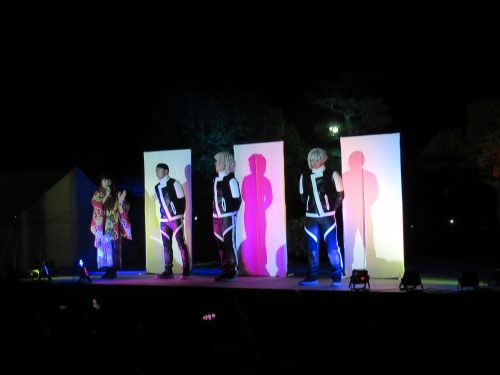
Hiroshima Castle Yoasobi is indeed a good use of the castle grounds after the sky goes dark, so I commend the affiliated groups for this idea. In addition, the introduction of warrior troupes from other castles all over Japan has the effect of advertising tourism to other prefectures, which worked for me, as I now want to hit up Okazaki Castle, which I have yet to see, and to re-visit Kumamoto Castle, which could use my support after the earthquake in 2016. All in all, drawing families downtown on a Saturday night is a good thing, giving kids a reason to stay up later, and bolstering Hiroshima’s economy and reputation further. The event taking place on National Foundation Day may have been a coincidence, but events like Yoasobi at Hiroshima Castle will certainly help to build a stronger foundation for the future of Hiroshima’s tourism sector.
Written by the Joy in Hiroshima Team
